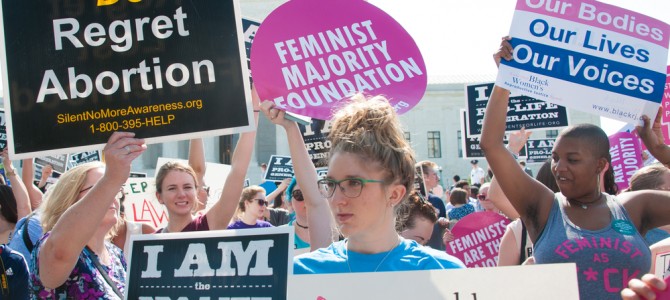
When five Supreme Court justices in the Texas abortion decision in June (Whole Woman’s Health v. Hellerstedt) threw out long-standing, generally applicable health and safety standards for abortion clinics, saying these created too much of a burden, the Five ignored mountains of evidence about medical risks and substandard providers in substandard clinics.
The opinion five justices issued virtually invites a sustained rebuke because their cherry-picking through all kinds of medical data and evidence looked more like the work of abortion advocates than impartial judges. The central problem for the justices after Hellerstedt is that they don’t know what they don’t know about abortion, and they claimed to need more information to remedy their deficit.
In the wake of Hellerstedt, there are compelling reasons state legislators should continue to emphasize the negative impact of abortion on women in crafting legislation to protect women in their states.
1. First-Trimester Regulations Okayed
First, the media coverage since June 27 has virtually ignored that the Supreme Court, for the very first time since Roe v. Wade, indicated—but only implicitly—that health and safety regulations were okay in the first trimester (when 90 percent of abortions are done). The court specifically acknowledged the importance of abortion facilities being “inspected at least annually” and including appropriate enforcement mechanisms, such as civil and criminal penalties, in abortion regulations and restrictions.
Unfortunately, they struck down the actual regulations in front of them coupled—as they have done many times in the past since 1973—with the vague assurance that the states have an interest in protecting “maternal health.”
2. Abortion Spawns Ghastly Hellholes
Second, the public health vacuum in abortion clinics across the country isn’t going away. It exists, and the justices created it in Roe v. Wade by prohibiting all health and safety regulations in the first trimester, when 90 percent of abortions occur. (The court also reaffirmed that prohibition in repeated cases throughout the 1970s and 1980s.) Hence, the public health vacuum states have tried to fill, bit by bit, in the face of hostility by federal judges. Hence, the Kermit Gosnells and Leroy Carharts and many others who were allowed to operate “houses of horrors” where women and unborn infants perished.
The history of dangerous conditions and abortion clinic scandals since 1973 is long, detailed, and depressing, and it continues. It doesn’t protect women’s health when the media refuses to report these scandals, resolutely refusing to question any abortion practices publicly on the supposed justification that population control is more important than any risks of abortion.
The five justices waved off the Gosnell murder conviction in Philadelphia in 2012 with the weak off-hand remark that bad people will always evade the law. (Does that apply to gun regulations, too?) But this specifically ignores what the Philadelphia grand jury found and reported publicly: that heightened medical standards, including regulations on sufficiently broad hallways, were needed to protect women’s health along with regular inspections.
3. The Supreme Court Relied Upon Bad Data
Third, the Five confidently cited the notion that “abortion is safer than childbirth.” That myth has long ago been exploded. The published abortion mortality rate and the published childbirth mortality rate are non-comparable. What goes into the numerator and denominator of each is completely different. There is no basis for comparison.
The former director of the Centers for Disease Control and Prevention (CDC) said the two published rates should not be compared because they are different measures. Although this has been clear for years, the Five cherry-picked this notion, while ignoring much contrary evidence in briefs filed in the Supreme Court.
4. Give ‘Em the Evidence They Want of Harm to Women
Fourth, the Five did not consider the growing body of peer-reviewed international studies finding increased medical risks of pre-term birth, mental trauma, and breast cancer after abortion. An increased risk is not the same as causation, but every woman seeking abortion should be informed of this body of international, peer-reviewed data. The increased risk of pre-term abortion after abortion, for example, is supported by studies of women from more than 30 countries.
Since the Five implied more medical evidence is needed, Congress should pass a National Abortion Data Reporting law this summer. None has existed in the 43 years since Roe. There are only two sources of national data, and reporting to both is completely voluntary. California, which used to report one-quarter to one-third of all abortions annually, reports its data to the CDC only sporadically. That annual figure the CDC and the media so confidently report is only an estimate. Consequently, no one can confidently know the rate of complications after abortion. Until there is reliable national data, women are making decisions in the dark without fully informed consent.
Obviously, pro-life Americans are concerned about the fate of the unborn child killed in an abortion, but the Supreme Court has long since rejected those sentiments in favor of focusing only on one person involved who is outside the womb. Since the court has made the interests of women the only issue, any strategy worth pursuing will include those interests.
Moreover, the nature of abortion puts the mother and child, together, at the center of the decision. The Supreme Court sticks to Roe v. Wade based on the assumption that abortion is good for women. In every pregnancy, various factors may affect the health of mother and child, and Americans care about the health of both. We’ve known since at least the Gallup poll of 1990 on “Abortion and Moral Belief” that many Americans see legal abortion as a “necessary evil” because of some sense (however vague or uncertain) that legal abortion is “good” for women. So focusing on the baby alone does not take account of medical, legal, and social realities.
Hopefully the pro-life movement will have the courage and resilience to be on the side of women for the long-term, despite the recent blowback from five agenda-driven justices. There’s more than enough reason and evidence to do so.









